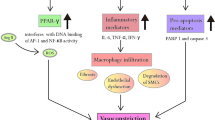Abstract
Objective
CCL23 [Ckβ8-1/myeloid progenitor inhibitory factor 1 (MPIF1)/macrophage inflammatory protein-3 (MIP3)], a member of the CC chemokine family, is involved in leukocyte trafficking, and implicated in inflammatory diseases. In the present study, we investigated the role of CCL23 in the development of human atherosclerosis, which is characterized by an inflammatory disease.
Methods
CCL23 transcripts were measured by reverse transcriptase-polymerase chain reaction (RT-PCR) and CCL23 protein by immunohistochemistry and enzyme-linked immunosorbent assay (ELISA). Expression of adhesion molecules was determined by flow cytometry, and matrix metalloproteinase-2 (MMP-2) levels by zymography.
Results
Proatherogenic factors such as oxidized low-density lipoprotein (oxLDL) and oxidative stress markedly enhanced CCL23 release from human THP-1 macrophages. CCL23 stimulated chemotaxis of human THP-1 monocytes in a dose-dependent manner and enhanced the expression of adhesion molecule CD11c, as well as release of MMP-2 from the THP-1 monocytes. Moreover, CCL23 expression at the mRNA level was significantly higher in human atherosclerotic lesions than in normal arteries, and CCL23 protein was co-expressed with CD68, a specific marker for macrophages. Circulating levels of plasma CCL23 were higher in atherosclerotic patients than in normal subjects.
Conclusion
These findings suggest that CCL23 plays a role in the development of human atherosclerosis. CCL23 may be a useful target for the development of antiatherogenic agents.




Similar content being viewed by others
References
Reape TJ, Groot PH. Chemokines and atherosclerosis. Atherosclerosis. 1999;147:213–25.
Libby P. Inflammation in atherosclerosis. Nature. 2002;420:868–74.
Gu L, Okada Y, Clinton SK, Gerard C, Sukhova GK, Libby P, et al. Absence of monocyte chemoattractant protein-1 reduces atherosclerosis in low density lipoprotein receptor-deficient mice. Mol Cell. 1998;2:275–81.
Berahovich RD, Miao Z, Wang Y, Premack B, Howard MC, Schall TJ. Proteolytic activation of alternative CCR1 ligands in inflammation. J Immunol. 2005;174:7341–51.
Forssmann U, Delgado MB, Uguccioni M, Loetscher P, Garotta G, Baggiolini M. CKbeta8, a novel CC chemokine that predominantly acts on monocytes. FEBS Lett. 1997;408:211–6.
Kim J, Kim YS, Ko J. CKbeta8/CCL23 induces cell migration via the G(i)/G(o) protein/PLC/PKCdelta/NF-kappaB and is involved in inflammatory responses. Life Sci. 2010; 86:300-308.
Castillo L, Rohatgi A, Ayers CR, Owens AW, Das SR, Khera A, et al. Associations of four circulating chemokines with multiple atherosclerosis phenotypes in a large population-based sample: results from the dallas heart study. J Interferon Cytokine Res. 2010;30:339–47.
Kim CS, Kawada T, Yoo H, Kwon BS, Yu R. Macrophage inflammatory protein-related protein-2, a novel CC chemokine, can regulate preadipocyte migration and adipocyte differentiation. FEBS Lett. 2003;548:125–30.
Harrington JR. The role of MCP-1 in atherosclerosis. Stem Cells. 2000;18:65–6.
Matsumori A, Ono K, Nishio R, Igata H, Shioi T, Matsui S, et al. Modulation of cytokine production and protection against lethal endotoxemia by the cardiac glycoside ouabain. Circulation. 1997;96:1501–6.
Attiga FA, Fernandez PM, Weeraratna AT, Manyak MJ, Patierno SR. Inhibitors of prostaglandin synthesis inhibit human prostate tumor cell invasiveness and reduce the release of matrix metalloproteinases. Cancer Res. 2000;60:4629–37.
Newby AC. Dual role of matrix metalloproteinases (matrixins) in intimal thickening and atherosclerotic plaque rupture. Physiol Rev. 2005;85:1–31.
Kodali R, Hajjou M, Berman AB, Bansal MB, Zhang S, Pan JJ, et al. Chemokines induce matrix metalloproteinase-2 through activation of epidermal growth factor receptor in arterial smooth muscle cells. Cardiovasc Res. 2006;69:706–15.
Erridge C, Webb DJ, Spickett CM. 25-Hydroxycholesterol, 7beta-hydroxycholesterol and 7-ketocholesterol upregulate interleukin-8 expression independently of Toll-like receptor 1, 2, 4 or 6 signalling in human macrophages. Free Radic Res. 2007;41:260–6.
Yu R, Kim CS, Kawada T, Kwon TW, Lim TH, Kim YW, et al. Involvement of leukotactin-1, a novel CC chemokine, in human atherosclerosis. Atherosclerosis. 2004;174:35–42.
Braunersreuther V, Steffens S, Arnaud C, Pelli G, Burger F, Proudfoot A, et al. A novel RANTES antagonist prevents progression of established atherosclerotic lesions in mice. Arterioscler Thromb Vasc Biol. 2008;28:1090–6.
Hwang J, Son KN, Kim CW, Ko J, Na DS, Kwon BS, et al. Human CC chemokine CCL23, a ligand for CCR1, induces endothelial cell migration and promotes angiogenesis. Cytokine. 2005;30:254–63.
Son KN, Hwang J, Kwon BS, Kim J. Human CC chemokine CCL23 enhances expression of matrix metalloproteinase-2 and invasion of vascular endothelial cells. Biochem Biophys Res Commun. 2006;340:498–504.
Slevin M, Cao Y, Kitajewski J. Welcome to journal of angiogenesis research. J Angiogenes Res. 2009;1:1.
Sluimer JC, Daemen MJ. Novel concepts in atherogenesis: angiogenesis and hypoxia in atherosclerosis. J Pathol. 2009;218:7–29.
Kofler S, Nickel T, Weis M. Role of cytokines in cardiovascular diseases: a focus on endothelial responses to inflammation. Clin Sci (Lond). 2005;108:205–13.
Yoshidome H, Kohno H, Shida T, Kimura F, Shimizu H, Ohtsuka M, et al. Significance of monocyte chemoattractant protein-1 in angiogenesis and survival in colorectal liver metastases. Int J Oncol. 2009;34:923–30.
Acknowledgments
This work was supported by the 2009 Research Fund of the University of Ulsan.
Conflict of interest
No competing financial interests exist.
Author information
Authors and Affiliations
Corresponding author
Additional information
Responsible Editor: Makoto Katori.
Rights and permissions
About this article
Cite this article
Kim, CS., Kang, JH., Cho, HR. et al. Potential involvement of CCL23 in atherosclerotic lesion formation/progression by the enhancement of chemotaxis, adhesion molecule expression, and MMP-2 release from monocytes. Inflamm. Res. 60, 889–895 (2011). https://doi.org/10.1007/s00011-011-0350-5
Received:
Revised:
Accepted:
Published:
Issue Date:
DOI: https://doi.org/10.1007/s00011-011-0350-5




